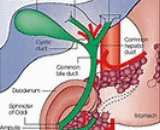Extrahepatic Cholestasis (EC)

Cholestasis is caused by obstruction within the liver (intrahepatic) or outside the liver (extrahepatic). The obstruction causes bile salts, the bile pigment bilirubin, and fats (lipids) to accumulate in the blood stream instead of being eliminated normally. Intrahepatic cholestasis is characterized by widespread blockage of small ducts or by disorders, such as hepatitis, that impair the body's ability to eliminate bile. Extrahepatic cholestasis can occur as a side effect of many medications. It can also occur as a complication of surgery, serious injury, tissue-destroying infection, or intravenous feeding. Extrahepatic cholestasis can be caused by conditions such as tumors and gallstones that block the flow of bile from the gallbladder to the first part of the small intestine (duodenum).
Organism species: Mus musculus (Mouse)
- Disease model DSI753Mu01 Mouse Model for Extrahepatic Cholestasis (EC) In Stock
- Customized Service n/a Tissue of Extrahepatic Cholestasis (EC) (If Necessary) Tissue Customized Service Offer
- Customized Service n/a Serums of Extrahepatic Cholestasis (EC) (If Necessary) Serums Customized Service Offer
Organism species: Rattus norvegicus (Rat)
- Disease model DSI753Ra01 Rat Model for Extrahepatic Cholestasis (EC) In Stock
- Customized Service n/a Tissue of Extrahepatic Cholestasis (EC) (If Necessary) Tissue Customized Service Offer
- Customized Service n/a Serums of Extrahepatic Cholestasis (EC) (If Necessary) Serums Customized Service Offer
Organism species: Cavia (Guinea pig )
- Disease model DSI753Gu01 Cavia Model for Extrahepatic Cholestasis (EC) In Stock
- Customized Service n/a Tissue of Extrahepatic Cholestasis (EC) (If Necessary) Tissue Customized Service Offer
- Customized Service n/a Serums of Extrahepatic Cholestasis (EC) (If Necessary) Serums Customized Service Offer
Organism species: Oryctolagus cuniculus (Rabbit)
- Disease model DSI753Rb01 Rabbit Model for Extrahepatic Cholestasis (EC) In Stock
- Customized Service n/a Tissue of Extrahepatic Cholestasis (EC) (If Necessary) Tissue Customized Service Offer
- Customized Service n/a Serums of Extrahepatic Cholestasis (EC) (If Necessary) Serums Customized Service Offer
Organism species: Canis familiaris; Canine (Dog)
- Disease model DSI753Ca01 Canine Model for Extrahepatic Cholestasis (EC) In Stock
- Customized Service n/a Tissue of Extrahepatic Cholestasis (EC) (If Necessary) Tissue Customized Service Offer
- Customized Service n/a Serums of Extrahepatic Cholestasis (EC) (If Necessary) Serums Customized Service Offer


